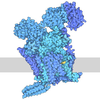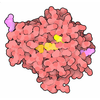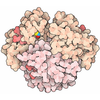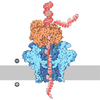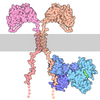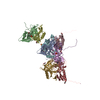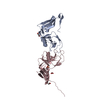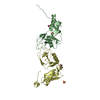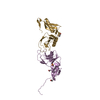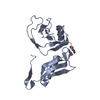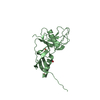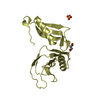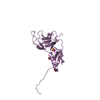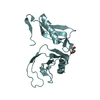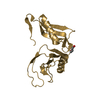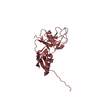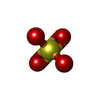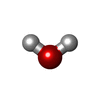[English] 日本語
 Yorodumi
Yorodumi- PDB-3ktm: Structure of the Heparin-induced E1-Dimer of the Amyloid Precurso... -
+ Open data
Open data
- Basic information
Basic information
| Entry | Database: PDB / ID: 3ktm | ||||||
|---|---|---|---|---|---|---|---|
| Title | Structure of the Heparin-induced E1-Dimer of the Amyloid Precursor Protein (APP) | ||||||
 Components Components | Amyloid beta A4 protein | ||||||
 Keywords Keywords | CELL ADHESION / SIGNALING PROTEIN / Protein Structure / Alzheimer disease / Amyloid / Amyloidosis / Apoptosis / Copper / Disease mutation / Disulfide bond / Endocytosis / Heparin-binding / Metal-binding / Neurodegeneration / Notch signaling pathway / Proteoglycan / Zinc | ||||||
| Function / homology |  Function and homology information Function and homology informationregulation of epidermal growth factor-activated receptor activity / cytosolic mRNA polyadenylation / collateral sprouting in absence of injury / microglia development / regulation of synapse structure or activity / regulation of Wnt signaling pathway / Formyl peptide receptors bind formyl peptides and many other ligands / axo-dendritic transport / synaptic assembly at neuromuscular junction / signaling receptor activator activity ...regulation of epidermal growth factor-activated receptor activity / cytosolic mRNA polyadenylation / collateral sprouting in absence of injury / microglia development / regulation of synapse structure or activity / regulation of Wnt signaling pathway / Formyl peptide receptors bind formyl peptides and many other ligands / axo-dendritic transport / synaptic assembly at neuromuscular junction / signaling receptor activator activity / axon midline choice point recognition / smooth endoplasmic reticulum calcium ion homeostasis / astrocyte activation involved in immune response / regulation of spontaneous synaptic transmission / mating behavior / NMDA selective glutamate receptor signaling pathway / ciliary rootlet / Lysosome Vesicle Biogenesis / PTB domain binding / Golgi-associated vesicle / neuron remodeling / Insertion of tail-anchored proteins into the endoplasmic reticulum membrane / positive regulation of amyloid fibril formation / Deregulated CDK5 triggers multiple neurodegenerative pathways in Alzheimer's disease models / nuclear envelope lumen / COPII-coated ER to Golgi transport vesicle / suckling behavior / dendrite development / presynaptic active zone / modulation of excitatory postsynaptic potential / TRAF6 mediated NF-kB activation / Advanced glycosylation endproduct receptor signaling / neuromuscular process controlling balance / The NLRP3 inflammasome / regulation of presynapse assembly / transition metal ion binding / negative regulation of long-term synaptic potentiation / regulation of multicellular organism growth / negative regulation of neuron differentiation / ECM proteoglycans / intracellular copper ion homeostasis / smooth endoplasmic reticulum / positive regulation of T cell migration / spindle midzone / Purinergic signaling in leishmaniasis infection / protein serine/threonine kinase binding / positive regulation of chemokine production / clathrin-coated pit / regulation of peptidyl-tyrosine phosphorylation / forebrain development / Notch signaling pathway / Mitochondrial protein degradation / neuron projection maintenance / positive regulation of G2/M transition of mitotic cell cycle / positive regulation of protein metabolic process / positive regulation of calcium-mediated signaling / ionotropic glutamate receptor signaling pathway / positive regulation of glycolytic process / response to interleukin-1 / cholesterol metabolic process / positive regulation of mitotic cell cycle / extracellular matrix organization / adult locomotory behavior / axonogenesis / platelet alpha granule lumen / trans-Golgi network membrane / positive regulation of peptidyl-threonine phosphorylation / positive regulation of interleukin-1 beta production / learning / dendritic shaft / positive regulation of long-term synaptic potentiation / central nervous system development / locomotory behavior / endosome lumen / astrocyte activation / positive regulation of JNK cascade / Post-translational protein phosphorylation / synapse organization / microglial cell activation / regulation of long-term neuronal synaptic plasticity / TAK1-dependent IKK and NF-kappa-B activation / serine-type endopeptidase inhibitor activity / visual learning / neuromuscular junction / recycling endosome / cognition / Golgi lumen / positive regulation of inflammatory response / neuron cellular homeostasis / positive regulation of non-canonical NF-kappaB signal transduction / positive regulation of interleukin-6 production / cellular response to amyloid-beta / endocytosis / Regulation of Insulin-like Growth Factor (IGF) transport and uptake by Insulin-like Growth Factor Binding Proteins (IGFBPs) / G2/M transition of mitotic cell cycle / positive regulation of tumor necrosis factor production / neuron projection development / cell-cell junction / synaptic vesicle / Platelet degranulation Similarity search - Function | ||||||
| Biological species |  Homo sapiens (human) Homo sapiens (human) | ||||||
| Method |  X-RAY DIFFRACTION / X-RAY DIFFRACTION /  SYNCHROTRON / SYNCHROTRON /  MOLECULAR REPLACEMENT / Resolution: 2.7 Å MOLECULAR REPLACEMENT / Resolution: 2.7 Å | ||||||
 Authors Authors | Dahms, S.O. / Hoefgen, S. / Roeser, D. / Schlott, B. / Guhrs, K.H. / Than, M.E. | ||||||
 Citation Citation |  Journal: Proc.Natl.Acad.Sci.USA / Year: 2010 Journal: Proc.Natl.Acad.Sci.USA / Year: 2010Title: Structure and biochemical analysis of the heparin-induced E1 dimer of the amyloid precursor protein. Authors: Dahms, S.O. / Hoefgen, S. / Roeser, D. / Schlott, B. / Guhrs, K.H. / Than, M.E. | ||||||
| History |
|
- Structure visualization
Structure visualization
| Structure viewer | Molecule:  Molmil Molmil Jmol/JSmol Jmol/JSmol |
|---|
- Downloads & links
Downloads & links
- Download
Download
| PDBx/mmCIF format |  3ktm.cif.gz 3ktm.cif.gz | 292.2 KB | Display |  PDBx/mmCIF format PDBx/mmCIF format |
|---|---|---|---|---|
| PDB format |  pdb3ktm.ent.gz pdb3ktm.ent.gz | 237.1 KB | Display |  PDB format PDB format |
| PDBx/mmJSON format |  3ktm.json.gz 3ktm.json.gz | Tree view |  PDBx/mmJSON format PDBx/mmJSON format | |
| Others |  Other downloads Other downloads |
-Validation report
| Arichive directory |  https://data.pdbj.org/pub/pdb/validation_reports/kt/3ktm https://data.pdbj.org/pub/pdb/validation_reports/kt/3ktm ftp://data.pdbj.org/pub/pdb/validation_reports/kt/3ktm ftp://data.pdbj.org/pub/pdb/validation_reports/kt/3ktm | HTTPS FTP |
|---|
-Related structure data
- Links
Links
- Assembly
Assembly
- Components
Components
| #1: Protein | Mass: 21762.080 Da / Num. of mol.: 8 / Fragment: UNP residues 18-190 Source method: isolated from a genetically manipulated source Source: (gene. exp.)  Homo sapiens (human) / Gene: APP, A4, AD1 / Plasmid: pET22b / Production host: Homo sapiens (human) / Gene: APP, A4, AD1 / Plasmid: pET22b / Production host:  #2: Chemical | ChemComp-BU4 / ( #3: Chemical | ChemComp-SO4 / #4: Chemical | ChemComp-ACT / #5: Water | ChemComp-HOH / | |
|---|
-Experimental details
-Experiment
| Experiment | Method:  X-RAY DIFFRACTION / Number of used crystals: 1 X-RAY DIFFRACTION / Number of used crystals: 1 |
|---|
- Sample preparation
Sample preparation
| Crystal | Density Matthews: 4.02 Å3/Da / Density % sol: 69.44 % |
|---|---|
| Crystal grow | Temperature: 293 K / Method: vapor diffusion, sitting drop / pH: 5 Details: pH 5.0, VAPOR DIFFUSION, SITTING DROP, temperature 293K |
-Data collection
| Diffraction | Mean temperature: 100 K |
|---|---|
| Diffraction source | Source:  SYNCHROTRON / Site: SYNCHROTRON / Site:  BESSY BESSY  / Beamline: 14.1 / Wavelength: 0.91841 Å / Beamline: 14.1 / Wavelength: 0.91841 Å |
| Detector | Type: MARMOSAIC 225 mm CCD / Detector: CCD / Date: Dec 19, 2008 Details: Double crystal monochromator with 2 sets of mirrors |
| Radiation | Protocol: SINGLE WAVELENGTH / Monochromatic (M) / Laue (L): M / Scattering type: x-ray |
| Radiation wavelength | Wavelength: 0.91841 Å / Relative weight: 1 |
| Reflection | Resolution: 2.7→29 Å / Num. obs: 74422 / % possible obs: 99.8 % / Redundancy: 2.1 % / Biso Wilson estimate: 69.152 Å2 / Rmerge(I) obs: 0.066 / Rsym value: 0.066 / Net I/σ(I): 10.8 |
| Reflection shell | Resolution: 2.7→2.85 Å / % possible obs: 99.7 % / Redundancy: 2 % / Rmerge(I) obs: 0.403 / Mean I/σ(I) obs: 2.1 / Num. unique all: 10822 |
- Processing
Processing
| Software |
| ||||||||||||||||||||
|---|---|---|---|---|---|---|---|---|---|---|---|---|---|---|---|---|---|---|---|---|---|
| Refinement | Method to determine structure:  MOLECULAR REPLACEMENT MOLECULAR REPLACEMENTStarting model: 1MWP, 2FJZ Resolution: 2.7→29 Å
| ||||||||||||||||||||
| Displacement parameters | Biso mean: 48.6 Å2 | ||||||||||||||||||||
| Refinement step | Cycle: LAST / Resolution: 2.7→29 Å
| ||||||||||||||||||||
| Refine LS restraints |
|
 Movie
Movie Controller
Controller




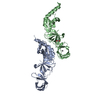
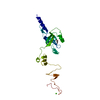
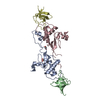

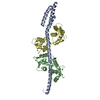
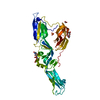
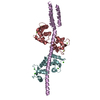
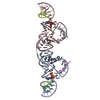
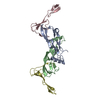

 PDBj
PDBj






